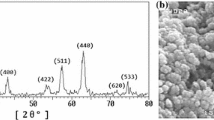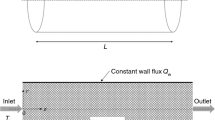Abstract
In this paper, TiO2–H2O nanofluids are used instead of traditional mediums such as water and oil as the heat transfer medium. For the purpose of research on the natural convection heat transfer characteristics of TiO2–H2O nanofluids in a cavity filled with metal foam, a natural convection experiment system filled with different pore density (PPI) copper foam was established. The experimental results showed that the filling of the metal foam greatly improves the heat transfer effect in the cavity. When the PPI of the metal foam copper is 5 and 25, the Nusselt numbers are similar and larger than that of PPI = 15. The heat transfer effect of water in a cavity with the PPI = 5, PPI = 15 and PPI = 25 metal foam can be enhanced by 58.8%, 31.4% and 63.3% compared with that without metal foam, respectively. The heat transfer effect increases with the concentration of nanofluids. TiO2–H2O nanofluids with 0.1%, 0.3% and 0.5% mass fraction can enhance heat exchange by 6.3%, 22.9% and 32.1% compared with water, respectively. In addition, as the heating power increases, the heat transfer is improved while the heat transfer enhancement efficiency deteriorates.








Similar content being viewed by others
References
Mostafazadeh A, Toghraie D, Mashayekhi R, Akbari OA. Effect of radiation on laminar natural convection of nanofluid in a vertical channel with single-and two-phase approaches. J Therm Anal Calorim. 2019;138(1):779–94.
Daniali OA, Toghraie D, Eftekhari SA. Thermo-hydraulic and economic optimization of Iranol refinery oil heat exchanger with copper oxide nanoparticles using MOMBO. Physica A. 2020;540:123010.
Mir S, Akbari OA, Toghraie D, Sheikhzadeh G, Marzban A, Mir S, Talebizadehsardari P. A comprehensive study of two-phase flow and heat transfer of water/Ag nanofluid in an elliptical curved minichannel. Chin J Chem Eng. 2019. https://doi.org/10.1016/j.cjche.2019.07.007.
Alrashed AAAA, Akbari OA, Heydari A, Toghraie D, Zarringhalam M, Shabani GAS, Seifi AR, Goodarzi M. The numerical modeling of water/FMWCNT nanofluid flow and heat transfer in a backward-facing contracting channel. Physica B. 2018;537:176–83.
Mashayekhi R, Arasteh H, Toghraie D, Motaharpour SH, Keshmiri A, Afrand M. Heat transfer enhancement of water–Al2O3 nanofluid in an oval channel equipped with two rows of twisted conical strip inserts in various directions: a two-phase approach. Comput Math Appl. 2019. https://doi.org/10.1016/j.camwa.2019.10.024.
Karimipour A, Esfe MH, Safaei MR, Semiromi DT, Jafari S, Kazi SN. Mixed convection of copper–water nanofluid in a shallow inclined lid driven cavity using the lattice Boltzmann method. Phys A Stat Mech Appl. 2014;402:150–68.
Esfandiary M, Mehmandoust B, Karimipour A. Natural convection of Al2O3–water nanofluid in an inclined enclosure with the effects of slip velocity mechanisms: Brownian motion and thermophoresis phenomenon. Int J Therm Sci. 2016;105:137–58.
Afrand M, Toghraie D, Karimipour A, Wongwises S. A numerical study of natural convection in a vertical annulus filled with gallium in the presence of magnetic field. J Magn Magn Mater. 2017;430:22–8.
Esfe MH, Akbari M, Karimipour A, Afrand M. Mixed-convection flow and heat transfer in an inclined cavity equipped to a hot obstacle using nanofluids considering temperature-dependent properties. Int J Heat Mass Transf. 2015;85:656–66.
Sheikholeslami M. Numerical simulation of magnetic nanofluid natural convection in porous media. Phys Lett A. 2017;381:494–503.
Sheikholeslami M, Gorji-Bandpy M, Ganji DD. Lattice Boltzmann method for MHD natural convection heat transfer using nanofluid. Powder Technol. 2014;254:82–93.
Garoosi F, Hoseininejad F, Rashidi MM. Numerical study of natural convection heat transfer in a heat exchanger filled with nanofluids. Energy. 2016;109:664–78.
Makulati N, Kasaeipoor A, Rashidi MM. Numerical study of natural convection of a water–alumina nanofluid in inclined c-shaped enclosures under the effect of magnetic field. Adv Powder Technol. 2016;27(2):661–72.
Armaghani T, Kasaeipoor A, Alavi N, Rashidi MM. Numerical investigation of water–alumina nanofluid natural convection heat transfer and entropy generation in a baffled L-shaped cavity. J Mol Liq. 2016;223:243–51.
Chen Y, Wang P, Liu Z. Numerical study of natural convection characteristics of nanofluids in an enclosure using multiphase model. Heat Mass Transf. 2016;52(11):1–14.
Kolsi L. Numerical study of natural convection and entropy generation of Al2O3–water nanofluid within a cavity equipped with a conductive baffle. J Appl Fluid Mech. 2016;9(5):2177–86.
Triveni MK, Sen D, Panua R. Numerical study of laminar natural convection in an arch enclosure filled with Al2O3–water based nanofluid. J Appl Fluid Mech. 2016;9(4):1927–2936.
Mahmoudi A, Mejri I, Omri A. Study of natural convection cooling of a nanofluid subjected to a magnetic field. Phys A Stat Mech Appl. 2016;451:333–48.
Qi C, He Y, Yan S, Tian F, Hu Y. Numerical simulation of natural convection in a square enclosure filled with nanofluid using the two-phase lattice Boltzmann method. Nanoscale Res Lett. 2013;8(1):56–71.
Qi C, He Y, Hu Y, Yang J, Li F, Ding Y. Natural convection of Cu–gallium nanofluid in enclosures. ASME J Heat Transf. 2011;133(12):122504.
Qi C, Wang G, Yang L, Wan Y, Rao Z. Two-phase lattice Boltzmann simulation of the effects of base fluid and nanoparticle size on natural convection heat transfer of nanofluid. Int J Heat Mass Transf. 2017;105:664–72.
Qi C, Cui X, Liu Y, Yang Z, Huang C. Natural convection heat transfer of liquid metal gallium nanofluids in a rectangular enclosure. Heat Transf Asian Res. 2015;46(1):1–17.
Gholami M, Nazari MR, Talebi MH, Pourfattah F, Akbari OA, Toghraie D. Natural convection heat transfer enhancement of different nanofluids by adding dimple fins on a vertical channel wall. Chin J Chem Eng. 2019. https://doi.org/10.1016/j.cjche.2019.11.001.
Karbasifar B, Akbari M, Toghraie D. Mixed convection of water–aluminum oxide nanofluid in an inclined lid-driven cavity containing a hot elliptical centric cylinder. Int J Heat Mass Transf. 2018;116:1237–49.
Li Z, Barnoon P, Toghraie D, Dehkord RB, Afrand M. Mixed convection of non-Newtonian nanofluid in an H-shaped cavity with cooler and heater cylinders filled by a porous material: two phase approach. Adv Powder Technol. 2019;30(11):2666–85.
Esfe MH, Arani AAA, Rezaie M, Yan W, Karimipour A. Experimental determination of thermal conductivity and dynamic viscosity of Ag–MgO/water hybrid nanofluid. Int Commun Heat Mass Transf. 2015;66:189–95.
Ghasemi S, Karimipour A. Experimental investigation of the effects of temperature and mass fraction on the dynamic viscosity of CuO-paraffin nanofluid. Appl Therm Eng. 2018;128:189–97.
Ruhani B, Toghraie D, Hekmatifar M, Hadian M. Statistical investigation for developing a new model for rheological behavior of ZnO–Ag (50%–50%)/water hybrid Newtonian nanofluid using experimental data. Physica A. 2019;525:741–51.
Ruhani B, Barnoon P, Toghraie D. Statistical investigation for developing a new model for rheological behavior of silica–ethylene glycol/water hybrid Newtonian nanofluid using experimental data. Physica A. 2019;525:616–27.
Afshari A, Akbari M, Toghraie D, Yazdi ME. Experimental investigation of rheological behavior of the hybrid nanofluid of MWCNT–alumina/water (80%)–ethylene-glycol (20%). J Therm Anal Calorim. 2018;132(2):1001–15.
Afrand M, Najafabadi KN, Akbari M. Effects of temperature and solid volume fraction on viscosity of SiO2–MWCNTs/SAE40 hybrid nanofluid as a coolant and lubricant in heat engines. Appl Therm Eng. 2016;102:45–54.
Ho C, Liu W, Chang C, Lin C. Natural convection heat transfer of alumina–water nanofluid in vertical square enclosures: an experimental study. Int J Therm Sci. 2010;49:1345–53.
Ilyas SU, Pendyala R, Narahari M. An experimental study on the natural convection heat transfer in rectangular enclosure using functionalized alumina-thermal oil-based nanofluids. Appl Therm Eng. 2017;127:765–75.
Shi L, He Y, Hu Y, Wang X. Thermophysical properties of Fe3O4@CNT nanofluid and controllable heat transfer performance under magnetic field. Energy Convers Manag. 2018;177:249–57.
Hu Y, He Y, Qi C, Jiang B, Schlaberg HI. Experimental and numerical study of natural convection in a square enclosure filled with nanofluid. Int J Heat Mass Transf. 2014;78(78):380–92.
Nayak AK, Kulkarni PP, Chinchole AS, Mulye SM. Experimental and numerical investigation on natural convection heat transfer in nanofluids. Kerntechnik. 2016;81(1):60–6.
Hadi G, Mohsen S, Petrus JM. Experimental investigation on cavity flow natural convection of Al2O3–water nanofluids. Int Commun Heat Mass Transf. 2016;76:316–24.
Kouloulias K, Sergis A, Hardalupas Y. Sedimentation in nanofluids during a natural convection experiment. Int J Heat Mass Transf. 2016;101:1193–203.
Qi C, Wan Y, Wang G, Han D. Study on stabilities, thermophysical properties and natural convective heat transfer characteristics of TiO2–water nanofluids. Indian J Phys. 2018;92(4):461–78.
Cioni S, Ciliberto S, Sommeria J. Experimental study of high-Rayleigh-number convection in mercury and water. Dyn Atmos Oceans. 1996;24(1):117–27.
Acknowledgements
This work is financially supported by “National Natural Science Foundation of China, China” (Grant No. 51606214), and “Natural Science Foundation of Jiangsu Province, China” (Grant No. BK20181359).
Author information
Authors and Affiliations
Corresponding author
Additional information
Publisher's Note
Springer Nature remains neutral with regard to jurisdictional claims in published maps and institutional affiliations.
Rights and permissions
About this article
Cite this article
Wang, G., Qi, C. & Tang, J. Natural convection heat transfer characteristics of TiO2–H2O nanofluids in a cavity filled with metal foam. J Therm Anal Calorim 141, 15–24 (2020). https://doi.org/10.1007/s10973-020-09471-8
Received:
Accepted:
Published:
Issue Date:
DOI: https://doi.org/10.1007/s10973-020-09471-8




